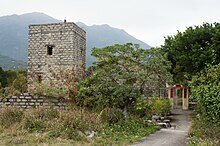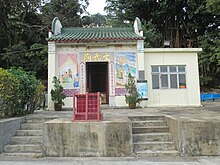Mui Wo
Today, it is still the principal way of reaching South Lantau – from the beaches in Cheung Sha to the fishing village of Tai O and the Tian Tan Buddha.
Fleeing south from the invading Yuan dynasty, in 1277 the Southern Song imperial court sought refuge in Silvermine Bay (at that time known as Mei Yu or 梅蔚).
In March 1278, whilst attempting a further escape from the Mongols, the penultimate Song emperor Duanzong fell from a boat and almost drowned.
[4] A silver and lead mine, close to the settlement of Pak Ngan Heung and Sivermine Waterfall, formally opened in March 1886.
People can only enter the first ten metres or so as the rest of the tunnels have been blocked off for safety reasons, and to prevent disturbance to the rare species of bats who live there.
[7] Japanese soldiers killed at least nine people and arrested 300 Mui Wo villagers in the weeks after Japan surrendered on 15 August 1945, ending the Second World War.
[10] There is a small local museum with old photos of Mui Wo and rural artefacts located behind the Silvermine Bay Resort Hotel.
Leisure and Cultural Services Department life guards patrol it and there is a shark net to protect swimmers April through October.
In 2009, residents protested against and blocked a plan[12] for a rehabilitation centre for drug offenders—the Christian Zheng Sheng College—to take over the site.
[17] The cartoonist Larry Feign, who wrote and drew The World of Lily Wong, lives in Wang Tong (橫塘), a village in Mui Wo.
Buses operate from Mui Wo to other places on Lantau, including Tung Chung (3M) and thus Hong Kong Airport (A35) and the rail network.
The Hong Kong Air Cadet Corps operate a helipad at the end of Mui Wo Ferry Pier Road that is close to the sewage plant.






